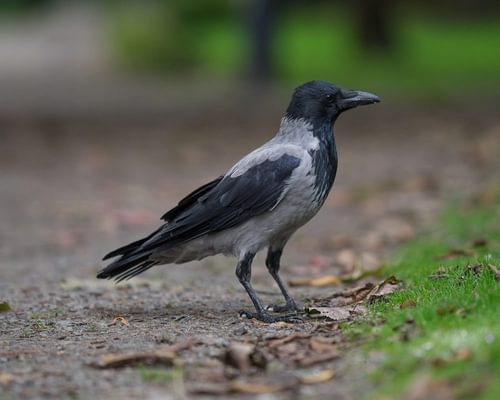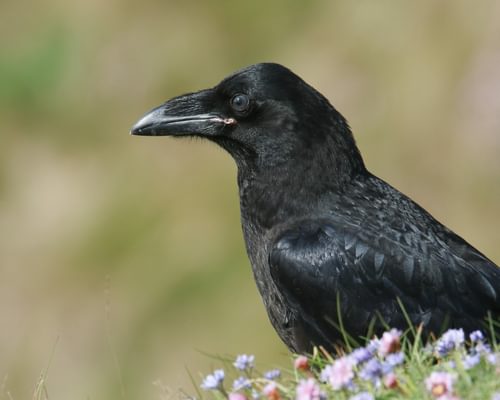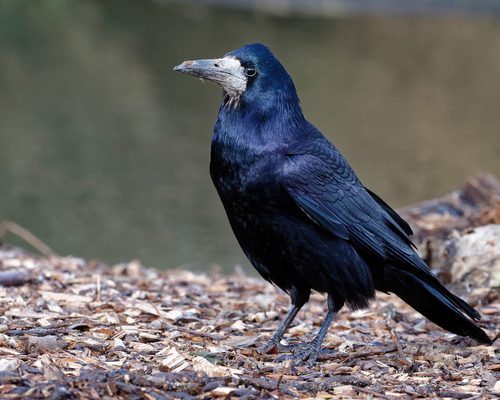Carrion Crow
Corvus corone
Visual Identification
Appearance
The Carrion Crow is a medium-sized bird with entirely black plumage that often displays a glossy, iridescent sheen in sunlight. Its stout, slightly curved beak and strong legs are also black, complementing its dark appearance.
Both males and females look identical, making visual sex determination challenging. Juveniles have a slightly duller plumage and may show a brownish tinge until their first moult.
Size
Length
44cm to 51cm
Wingspan
84cm to 100cm
Weight
400g to 600g
Colours
Males and females have similar plumage
Primary Colour
Black
Secondary Colour
Iridescent
Beak Colour
Black
Leg Colour
Black
Habitat and Distribution
Habitats
Woodland
Garden
Wetland
Coastal
Urban
Farmland
Grassland
Desert
Tundra
Rainforest
Mountain
Savanna
Distribution
Carrion Crows are widely distributed across Europe and parts of western Asia. They inhabit various environments, including woodlands, farmlands, grasslands, and urban areas. These adaptable birds are particularly successful in human-modified landscapes.
In the UK, Carrion Crows are common residents throughout England, Wales, and Scotland, except for the far north, where they're replaced by Hooded Crows. They're also found in parts of Ireland, though less abundantly.
Elevation Range
Sea level to 2,000 meters
Climate zones
Temperate, Subtropical
Distribution Map
This map gives you a rough idea of where you might spot a Carrion Crow. The coloured areas show countries where these birds have been seen.
A few things to keep in mind:
- Birds might not be everywhere in the coloured areas, for example, they may be present around the coast of that country
- Where birds live can change with seasons and available food
- This map is quite simple - it doesn't show exact locations
We're working on making our maps even better! Soon, we hope to show you:
- More detailed maps for bigger countries, including state and region
- How birds move around during different seasons
Distribution by Region
Behaviour and Ecology
Bird Attributes
This feature is in beta. We'd love your feedback to improve it!
Share your thoughtsBird Attributes Explained
Our bird attributes system rates various aspects of a bird's capabilities on a scale of 0-100, based on data from field observations, scientific studies, and expert knowledge.
Attribute Categories:
- Agility: Manoeuvrability, speed, and grace in flight or movement.
- Strength: Physical power, often correlating with size and hunting abilities.
- Adaptability: Ability to thrive in various environments or changing conditions.
- Aggressiveness: Territorial behaviour and assertiveness, particularly during breeding seasons.
- Endurance: Stamina, often seen in migration patterns or foraging behaviours.
Understanding the Ratings:
- 0-20: Very Low
- 21-40: Low
- 41-60: Average
- 61-80: High
- 81-100: Very High
Remember, these attributes are relative to other bird species and don't necessarily indicate superiority.
Hover over the icon next to each attribute for more information.
Tap the icon next to each attribute for more information.
Agility
Reflects the bird's manoeuvrability, speed, and grace in flight or movement.
The Carrion Crow demonstrates remarkable agility in flight and on the ground. Their ability to navigate complex urban environments, perform aerial displays during courtship, and execute precise movements when using tools all point to a high level of agility.
Strength
Indicates the bird's physical power, often correlating with size and hunting abilities.
Whilst not the strongest bird, Carrion Crows possess considerable strength for their size. Their ability to crack open nuts, defend territories, and carry substantial nesting materials indicates a good degree of physical power.
Adaptability
Represents the bird's ability to thrive in various environments or changing conditions.
Carrion Crows excel in adaptability. Their success in diverse habitats from woodlands to urban areas, coupled with their problem-solving skills and varied diet, showcases their exceptional ability to adapt to different environments and challenges.
Aggressiveness
Measures the bird's territorial behaviour and assertiveness, particularly during breeding seasons.
These birds display significant aggression, particularly during breeding season when defending their territories. Their boldness in urban settings and willingness to mob potential predators also contribute to this rating. However, they're not considered overly aggressive compared to some other species.
Endurance
Reflects the bird's stamina, often seen in migration patterns or foraging behaviours.
Carrion Crows exhibit strong endurance, evidenced by their ability to forage over large areas, defend territories for extended periods, and thrive in various climates. Their success as a species across a wide geographical range further supports their high endurance rating.
Diet
Carrion Crows are opportunistic omnivores with a diverse diet. They feed on carrion, small mammals, birds, eggs, insects, worms, seeds, and fruits.
In urban areas, they've adapted to scavenge human food waste. Their intelligence allows them to access food creatively, such as dropping nuts onto roads to crack them open.
Behaviour
Carrion Crows are highly intelligent and social birds. They often gather in small groups to forage, displaying cooperative behaviours.
These birds are known for their problem-solving skills, using tools and exhibiting complex social interactions. They're also territorial during the breeding season, fiercely defending their nesting areas.
Vocalisation
The Carrion Crow's call is a distinctive, harsh 'caw' or 'kra', often repeated in a series. They have a varied vocal repertoire, including softer, more melodious sounds used in close social interactions.
Some crows have been observed mimicking human-made sounds in urban settings, showcasing their vocal adaptability.
Nesting & Breeding
Carrion Crows typically form monogamous pairs that may bond for life. The breeding season usually begins in April and extends through June. Males perform aerial displays and offer food to attract mates.
Nests are built high in trees or on man-made structures, constructed with sticks and lined with softer materials like grass, wool, and moss. Females lay 3-6 pale blue-green eggs with brown speckles.
Incubation lasts about 18-20 days, primarily by the female. Both parents feed the nestlings, which fledge after 28-35 days but remain dependent on their parents for several more weeks.
Conservation and Status
Global Conservation Status
The Carrion Crow is listed as Least Concern by the IUCN due to its large range and stable population. However, like many birds, it faces challenges from habitat loss and climate change.
In some areas, conflicts with human activities have led to control measures, highlighting the need for balanced management approaches.
Birdwatching Tips
- Look for Carrion Crows in open landscapes, parks, and urban areas
- Listen for their distinctive harsh 'caw' call
- Observe their intelligent behaviour, such as tool use or problem-solving
- In the UK, watch for them in both rural and urban settings
Additional Information
Quick Facts
Predators
Did You Know?
- Carrion Crows can recognise and remember individual human faces for years.
- They've been observed creating and using tools in the wild, a sign of high intelligence.
- In some parts of their range, Carrion Crows hybridise with Hooded Crows, creating birds with mixed plumage.
Similar Birds
References
- 1 2
website: BirdLife International. 2017. Corvus corone (amended version of 2016 assessment). The IUCN Red List of Threatened Species 2017: e.T22706016A118784397.
View source - 3
report, 2015: EBCC
- 4
website, 2010: Fransson et al., EURING list of longevity records for European birds
View source
Share Your Feedback
We value your opinion! Let us know what you think about this bird page.



